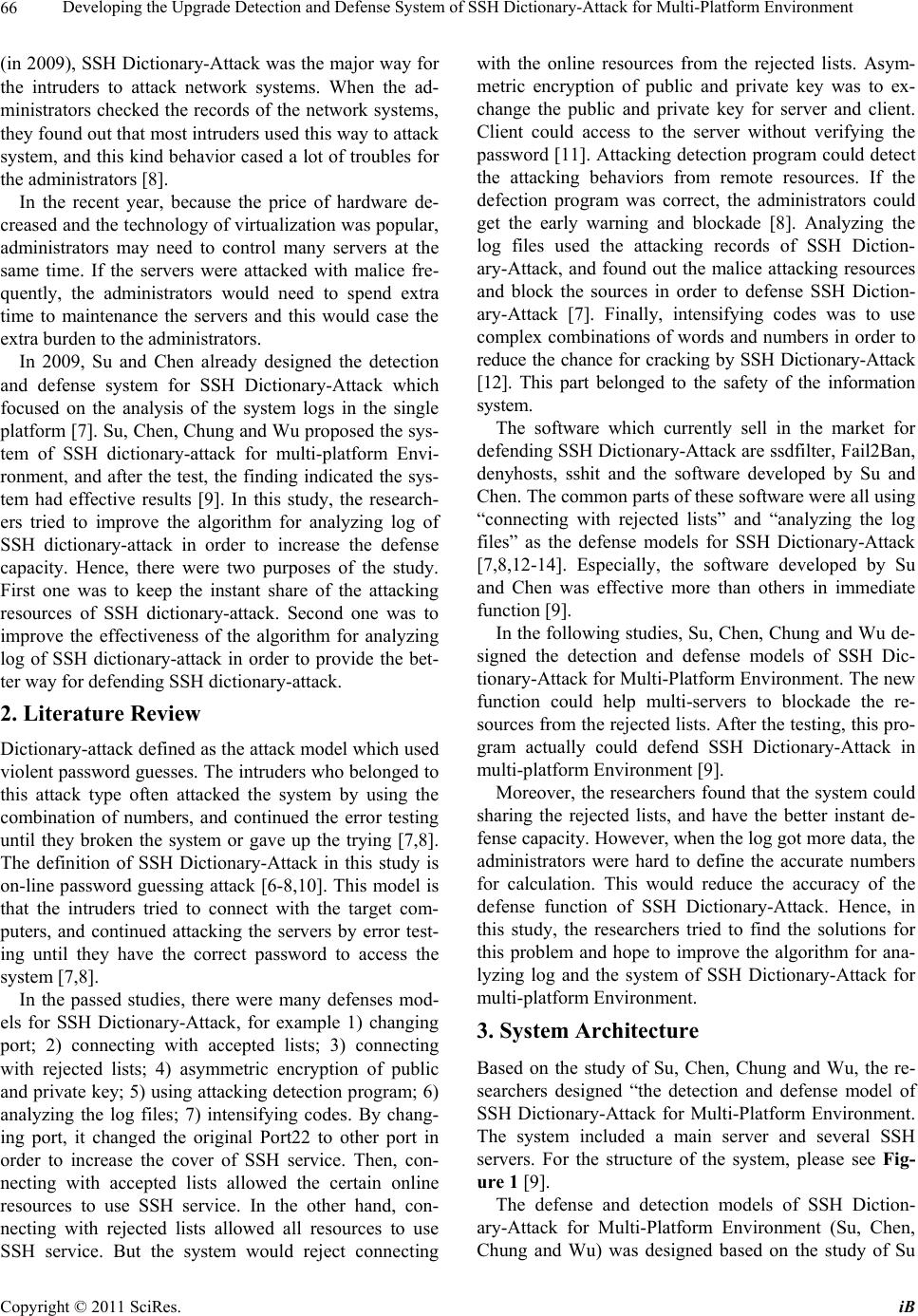
Developing the Upgrade Detection and Defense System of SSH Dictionary-Attack for Multi-Platform Environment
66
(in 2009), SSH Dictionary-Attack was the major way for
the intruders to attack network systems. When the ad-
ministrators checked the records of the network systems,
they found out that most intruders used this way to attack
system, and this kind behavior cased a lot of troubles for
the administrators [8].
In the recent year, because the price of hardware de-
creased and the technology of virtualization was popular,
administrators may need to control many servers at the
same time. If the servers were attacked with malice fre-
quently, the administrators would need to spend extra
time to maintenance the servers and this would case the
extra burden to the administrators.
In 2009, Su and Chen already designed the detection
and defense system for SSH Dictionary-Attack which
focused on the analysis of the system logs in the single
platform [7]. Su, Chen, Chung and Wu proposed the sys-
tem of SSH dictionary-attack for multi-platform Envi-
ronment, and after the test, the finding indicated the sys-
tem had effective results [9]. In this study, the research-
ers tried to improve the algorithm for analyzing log of
SSH dictionary-attack in order to increase the defense
capacity. Hence, there were two purposes of the study.
First one was to keep the instant share of the attacking
resources of SSH dictionary-attack. Second one was to
improve the effectiveness of the algorithm for analyzing
log of SSH dictionary-attack in order to provide the bet-
ter way for d efending SSH dictionary-at tack.
2. Literature Review
Dictionary-attack defined as the attack model which used
violent password guesses. The intruders who belonged to
this attack type often attacked the system by using the
combination of numbers, and continued the error testing
until they broken the system or gave up the trying [7,8].
The definition of SSH Dictionary-Attack in this study is
on-line password guessing attack [6-8,10]. This model is
that the intruders tried to connect with the target com-
puters, and continued attacking the servers by error test-
ing until they have the correct password to access the
system [7,8].
In the passed studies, there were many defenses mod-
els for SSH Dictionary-Attack, for example 1) changing
port; 2) connecting with accepted lists; 3) connecting
with rejected lists; 4) asymmetric encryption of public
and private key; 5) using attacking detection program; 6)
analyzing the log files; 7) intensifying codes. By chang-
ing port, it changed the original Port22 to other port in
order to increase the cover of SSH service. Then, con-
necting with accepted lists allowed the certain online
resources to use SSH service. In the other hand, con-
necting with rejected lists allowed all resources to use
SSH service. But the system would reject connecting
with the online resources from the rejected lists. Asym-
metric encryption of public and private key was to ex-
change the public and private key for server and client.
Client could access to the server without verifying the
password [11]. Attacking detection program could detect
the attacking behaviors from remote resources. If the
defection program was correct, the administrators could
get the early warning and blockade [8]. Analyzing the
log files used the attacking records of SSH Diction-
ary-Attack, and found out the malice attacking resources
and block the sources in order to defense SSH Diction-
ary-Attack [7]. Finally, intensifying codes was to use
complex combinations of words and numbers in order to
reduce the chance for cracking by SSH Dictionary-Attack
[12]. This part belonged to the safety of the information
system.
The software which currently sell in the market for
defending SSH Diction ary-Attack are ssdfilter, Fail2Ban,
denyhosts, sshit and the software developed by Su and
Chen. The common parts of these software were all using
“connecting with rejected lists” and “analyzing the log
files” as the defense models for SSH Dictionary-Attack
[7,8,12-14]. Especially, the software developed by Su
and Chen was effective more than others in immediate
function [9].
In the following stud ies, Su, Chen, Chung and Wu de-
signed the detection and defense models of SSH Dic-
tionary-Attack for Multi-Platform Environment. The new
function could help multi-servers to blockade the re-
sources from the rejected lists. After the testing, this pro-
gram actually could defend SSH Dictionary-Attack in
multi-platform Environment [9].
Moreover, the researchers found that the system could
sharing the rejected lists, and have the better instant de-
fense capacity. Howev er, when the log got more d ata, the
administrators were hard to define the accurate numbers
for calculation. This would reduce the accuracy of the
defense function of SSH Dictionary-Attack. Hence, in
this study, the researchers tried to find the solutions for
this problem and hope to improve the algorithm for ana-
lyzing log and the system of SSH Dictionary-Attack for
multi-platform Environment.
3. System Architecture
Based on the study of Su, Chen, Chung and Wu, the re-
searchers designed “the detection and defense model of
SSH Dictionary-Attack for Multi-Platform Environment.
The system included a main server and several SSH
servers. For the structure of the system, please see Fig-
ure 1 [9].
The defense and detection models of SSH Diction-
ary-Attack for Multi-Platform Environment (Su, Chen,
Chung and Wu) was designed based on the study of Su
Copyright © 2011 SciRes. iB